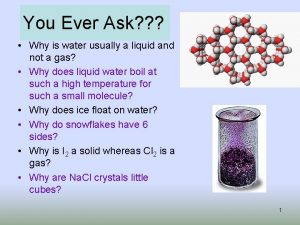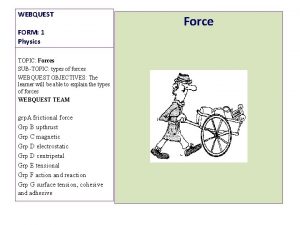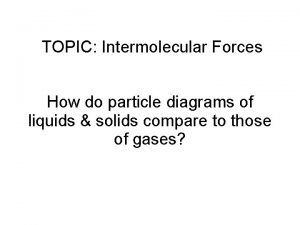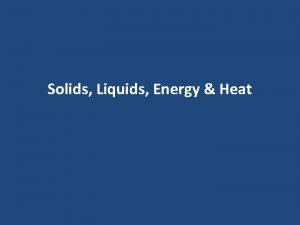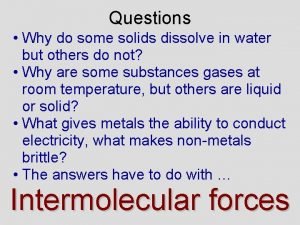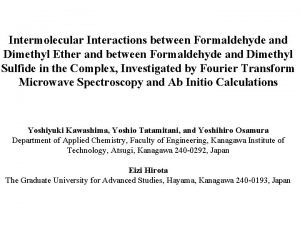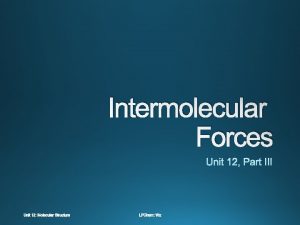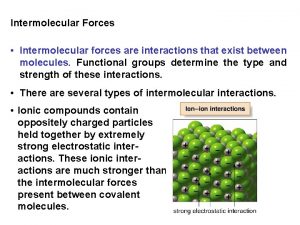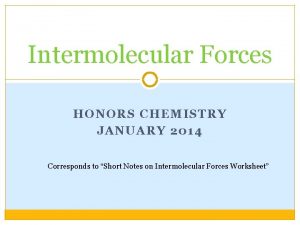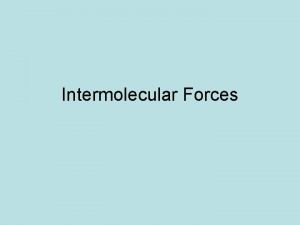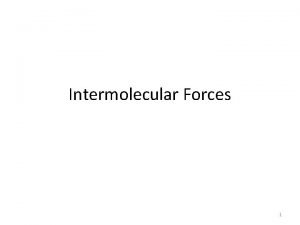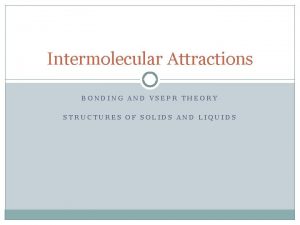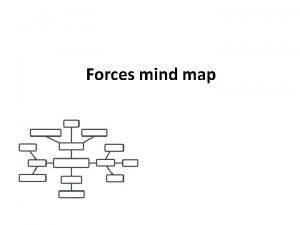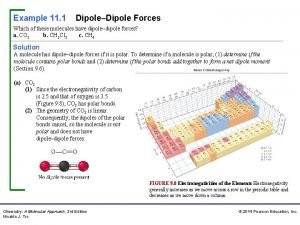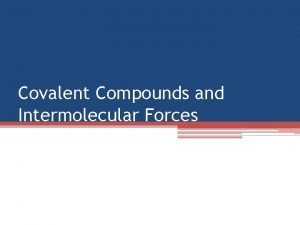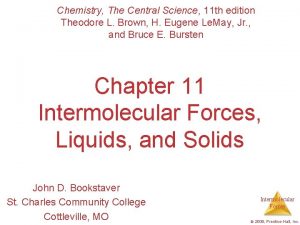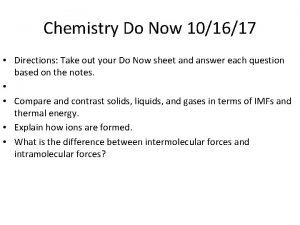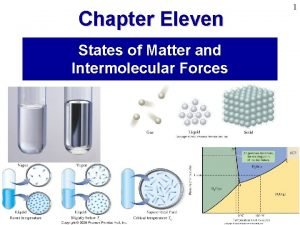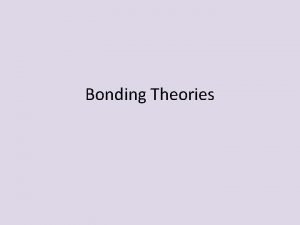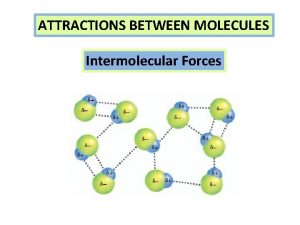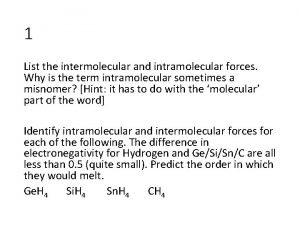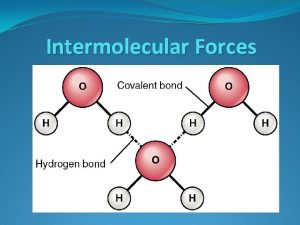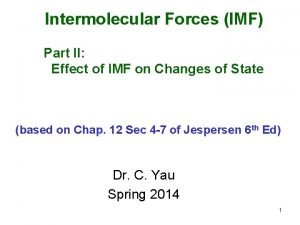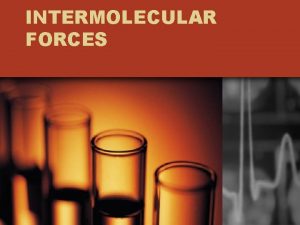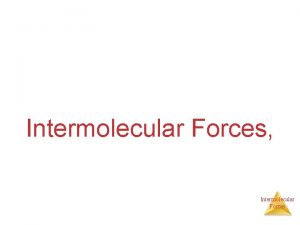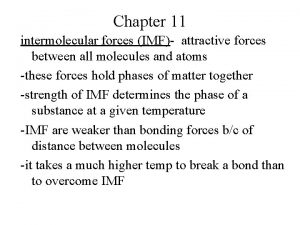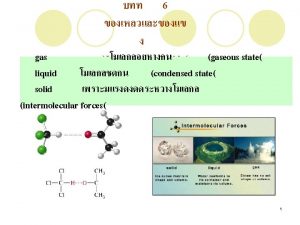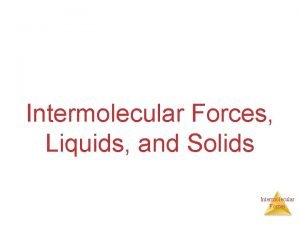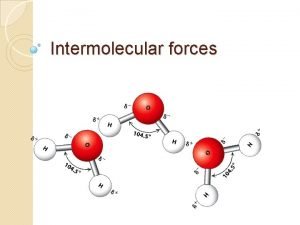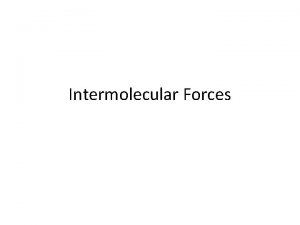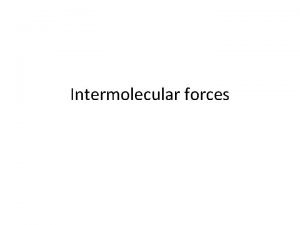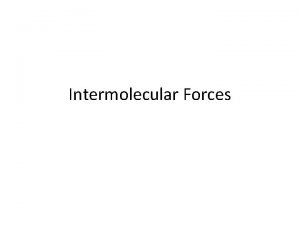Chapter 11 Intermolecular Forces IMF forces that exist











































- Slides: 43

Chapter 11 Intermolecular Forces (IMF)- forces that exist between molecules Gases -IMF not strong enough to hold particles together -assumes shape and volume of container -expands to fill container -compressible -flow readily -diffusion within a gas occurs readily

Liquids -IMF strong enough to hold particles close together -assumes shape of container -does not expand to fill container -incompressible -flows readily -diffusion within a liquid occurs slowly -known as a condensed phase b/c particles are fairly close together

Solids -IMF very strong- virtually locks particles in place -has definite shape and volume -incompressible -does not flow -diffusion within a solid occurs slowly -known as a condensed phase

-states of matter can be changed by heating or cooling -changes the average KE EX-dec the temp of a gas will dec KE and form a liquid and then lock particles in place to form a solid -inc pressure of a gas can bring molecules closer together to form a liquid and then a solid


IMF -usually much weaker than intramolecular forces (ionic, metallic or covalent bonds) -less energy is required to change a state of matter than to break a bond -boiling/melting pt. inc with stronger IMF -page 428 Table 11. 2

-all IMF are electrostatic **attractions between + and -weaker than bond b/c distances between molecules are often larger than the distances between atoms held together by bonds

Ion-Dipole Forces -exists between an ion and a polar molecule -cations are attracted to - end of a dipole -anions are attracted to + end -magnitude of attraction inc as either the ionic charge or the magnitude of the dipole inc -strongest IMF *only found in ionic compounds dissolved in solution

Ex: salt in water

Dispersion Forces (London Dispersion) -present in all molecules and atoms -weakest IMF -caused by motion of e- and instantaneous dipole moment -can cause an instantaneous dipole moment on an adjacent atom, causing the atoms to be attracted -page 429 Fig 11. 4

-fluctuations in the electron distribution in atoms and molecules result in a temporary dipole – region with excess electron density has partial (─) charge – region with depleted electron density has partial (+) charge


-strength depends on ease with which the charge distribution can be distorted -called polarizability -the greater the polarizability the more easily an e- cloud can be distorted to give an instantaneous dipole -more polarizable molecules have larger dispersion forces -polarizability inc. as the # of e- in an atom or molecule inc. -strength inc. with inc. molecular weight

-shape also influences- longer straight chains are stronger b/c molecules can come into contact along entire molecule -more compact = less contact

Dipole-Dipole Forces -exist in all polar molecules -polar molecules have permanent dipoles that interact with the permanent dipoles of neighboring molecules *+ end of polar molecule is attracted to – end of its neighbor -effective only when molecules are very close together

-all molecules (polar and non-polar) have dispersion forces -only polar also have dipole-dipole forces -this extra force raises melting/boiling pts compared to nonpolar molecules with similar molar masses

-for molecules of about equal mass and size, the strength of IMF inc. with inc. polarity Ex: CH 2 CN vs. CH 2 CH 3 Boiling pt. = 355 K and 231 K Mass= 40 amu and 43 amu *close masses so dispersion forces are similar *higher bp in CH 2 CN due to dipole-dipole forces -page 431 Figure 11. 8

Which of the following have dipole-dipole forces? 1) CO 2 -has polar bonds, but is nonpolar b/c it is linear no dipole-dipole forces 2) CH 2 Cℓ 2 -has polar bonds and net dipole has dipole-dipole forces 3) CH 4 -has nonpolar bonds no dipole-dipole forces

Hydrogen Bonding -occurs when polar molecules have H bonded to very electronegative atoms (N, O, and F) -H atom is attracted to nonbonding e- pair on another similar molecule -causes strong interaction between H and other atoms (N, O and F) in other molecules -second strongest IMF -substances with H-bonding have higher melting/boiling pts -water exhibits very strong H-bonding and this explains its behavior

-these two compounds have the same formula, but different structures which results in one having strong H-bonding and one not

In which of these substances is H bonding likely to play an important role in determining physical properties? methane CH 4 methyl fluoride CH 3 F hydrazine H 2 NNH 2 hydrogen sulfide H 2 S *consider Lewis structures **hydrazine**

Which one of the following compounds has a higher boiling point and why? -all have similar molar masses- similar dispersion forces -all are polar- all have dipole-dipole forces **hydrogen peroxide b/c it has H-bonding, harder to break apart


List the substances Ba. Cℓ 2, H 2, CO, HF, and Ne in order of inc boiling point. * Ba. Cℓ 2 is ionic *all others have dispersion forces *MW= 2, 28, 19. 9, 20. 2 *CO and HF have dipole-dipole b/c polar *HF has H-bonding H 2 < Ne < CO < HF < Ba. Cℓ 2

Identify the IMF present in the following substances and select the substance with the highest boiling point. 1) CH 3 2) CH 3 OH 3) CH 3 CH 2 OH 1) dispersion, MW= 30 amu 2) dispersion, d-d, H-bonding, MW= 32 amu 3) dispersion, d-d, H-bonding, MW= 46 amu *#3 has highest boiling point

Results of IMF 1) viscosity- the resistance of a liquid to flow -the higher the viscosity, the more slowly it flows -increases with greater IMF (or molar mass) b/c molecules cannot flow as easily -also depends on molecular shape- higher in longer molecules b/c they can become entangled -temp plays a part- the higher the temp, the lower the viscosity- higher KE can overcome the IMF

2) surface tension- inward force or pull that tends to minimize the surface area of a liquid -energy required to inc the surface area of a liquid by a unit amount -molecules with increased IMF have increased surface tension -water has an extremely high surface tension b/c of the strong H-bonding ex- forming spherical droplets, things being able to float on water -it is difficult to break the H-bonds -will dec by adding a surfactant (soap)

3) capillary action- ability of liquid to flow against gravity up a narrow tube cohesive forces- bind similar molecules to one another adhesive forces- bind a substance to a surface -if adhesive are greater than cohesive then the liquid will be drawn up -if cohesive are greater than adhesive than liquid does not rise -shape of meniscus determined by cohesion and adhesion

Phase Changes heat of fusion (∆Hfus) -amount of heat required to melt one mole of a solid - endothermic= + heat of solidification (∆Hsolid) -amount of heat required to solidify one mole of a liquid -exothermic= -same magnitude as ∆Hfus, but opposite sign b/c energy is given off

heat of vaporization (∆Hvap) -amount of heat required to vaporize one mole of a liquid - endothermic heat of condensation (∆Hcond) -amount of heat required to condense one mole of a gas to a liquid -exothermic -same magnitude as ∆Hvap, but opposite sign b/c energy is given off

heat of sublimation (∆Hsub) -goes from solid to gas without passing through liquid phase ∆Hsub= ∆Hfus + ∆Hvap -endothermic ex- frozen foods heat of deposition (∆Hdep) -gas to solid skipping liquid phase -exothermic -same magnitude as ∆Hsub, but opposite sign b/c energy is given off


Heating Curves -graph of temp vs. amount of heat added

-can calculate enthalpy change of a system for each segment of the heating curve -in AB, CD, and EF a single phase is heated from one phase to another use ∆H = m. C∆T -for BC use ∆Hfus -for DE use ∆Hvap *energy used up to increase distance between particles


-a gas normally liquefies at some point when pressure is applied -if temp inc, pressure must inc even more -if temp reaches a certain point no amount of pressure can cause a liquid to form -at that point, as pressure inc and the gas becomes more steadily compressed critical temp- the highest temp at which a distinct liquid phase can form critical pressure- pressure required to bring about liquefaction at this critical temp

-above the critical temp, the KE of the molecules is greater than the attractive forces that lead to the liquid state -the greater the IMF, the higher the critical temp supercritical fluid- occurs when critical temp and pressure are exceeded and the liquid and gas phases are indistinguishable from each other

vapor pressure- pressure above the surface of the liquid, causes evaporation -will be lower with stronger IMF -if a container is sealed, the liquid will still vaporize and condense, just not into the atmosphere -when rate of condensation equals rate of vaporization the liquid has reached dynamic equilibrium -vapor pressure of a liquid is the pressure exerted by its vapor when liquid and vapor are in dynamic equilibrium

-equilibrium never occurs when vaporization happens in an open container volatile- liquids that evaporate easily -have high vapor pressure ex- nail polish remover nonvolatile- liquids that do not vaporize easily -have low vapor pressure ex- motor oil -vapor pressure inc with inc temp- particles move more and can escape to gas phase

-a liquid boils when vapor pressure equals the external pressure acting on the liquid surface normal boiling point- boiling point of a liquid at 1 atm *the higher the pressure the higher the boiling pt *food takes longer to cook at higher elevations WHY? -pressure is lower, lowering boiling point of water below 100°C, taking longer to cook

phase diagram- summarizes conditions under which equilibria exists between the different states of matter -can be used to predict which phase of a substance is present at any given temp and pressure -page 445 Fig 11. 27

1) red curve is vapor pressure curve of liquid -equilibrium between liquid and gas phase -@ 1 atm is the normal boiling point -ends at the critical point (C)- critical temp and pressure -supercritical fluid beyond critical point 2) green curve is sublimation curve -separates the solid from the gas phase

3) blue curve is melting curve -separates solid phase from liquid phase -usually slopes to the right as pressure inc b/c most solids are denser than their liquids -@ 1 atm is the normal melting point triple point -point T, where three curves intersect -all three phases exist in equilibrium
 Intermolecular forces vs intramolecular forces
Intermolecular forces vs intramolecular forces Intermolecular forces vs intramolecular forces
Intermolecular forces vs intramolecular forces Covalent bond intermolecular forces
Covalent bond intermolecular forces Phân độ lown ngoại tâm thu
Phân độ lown ngoại tâm thu Block nhĩ thất độ 3
Block nhĩ thất độ 3 Thơ thất ngôn tứ tuyệt đường luật
Thơ thất ngôn tứ tuyệt đường luật Thơ thất ngôn tứ tuyệt đường luật
Thơ thất ngôn tứ tuyệt đường luật Chiến lược kinh doanh quốc tế của walmart
Chiến lược kinh doanh quốc tế của walmart Tìm vết của đường thẳng
Tìm vết của đường thẳng Hãy nói thật ít để làm được nhiều
Hãy nói thật ít để làm được nhiều Tôn thất thuyết là ai
Tôn thất thuyết là ai Gây tê cơ vuông thắt lưng
Gây tê cơ vuông thắt lưng Sau thất bại ở hồ điển triệt
Sau thất bại ở hồ điển triệt London dispersion forces induced dipole
London dispersion forces induced dipole Forces webquest
Forces webquest Intermolecular forces
Intermolecular forces 3 types of intermolecular forces
3 types of intermolecular forces Types of intermolecular forces
Types of intermolecular forces How intermolecular forces affect solvation
How intermolecular forces affect solvation Intermolecular forces present in hbr
Intermolecular forces present in hbr Pvc intermolecular forces
Pvc intermolecular forces Intermolecular forces of formaldehyde
Intermolecular forces of formaldehyde Intermolecular forces symbol
Intermolecular forces symbol Intramolecular forces
Intramolecular forces Strengths of intermolecular forces
Strengths of intermolecular forces 3 types of intermolecular forces
3 types of intermolecular forces Hydrogen bromide intermolecular forces
Hydrogen bromide intermolecular forces Strongest to weakest intermolecular forces
Strongest to weakest intermolecular forces Geckos and intermolecular forces
Geckos and intermolecular forces Intermolecular forces on vapor pressure
Intermolecular forces on vapor pressure Intermolecular forces from strongest to weakest
Intermolecular forces from strongest to weakest Similarities of intermolecular and intramolecular forces
Similarities of intermolecular and intramolecular forces Type of intermolecular forces
Type of intermolecular forces Strongest intermolecular force
Strongest intermolecular force Mind mapping about intermolecular forces
Mind mapping about intermolecular forces Ch2cl intermolecular forces
Ch2cl intermolecular forces Coh2 intermolecular forces
Coh2 intermolecular forces Viscosity and intermolecular forces
Viscosity and intermolecular forces Capillary action intermolecular forces
Capillary action intermolecular forces Is matter
Is matter Hybrid bonding
Hybrid bonding Attraction
Attraction Idf
Idf List of intermolecular forces
List of intermolecular forces













